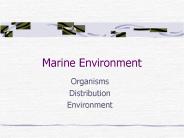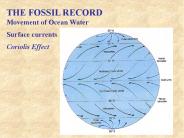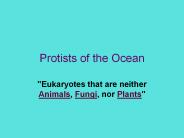Coccolithophores PowerPoint PPT Presentations
All Time
Recommended
They are unicellular marine planktonic protists (algae) with photosynthetic ... Coccolithophores live in the photic zone (the surface waters, where sunlight ...
| PowerPoint PPT presentation | free to view
The Prymnesiophyceae are the most abundant organisms of the nannoplankton (2-20 ... 1 in the midle-photic zone. 1 in the upper-photic zone ...
| PowerPoint PPT presentation | free to download
Introduction: coccolithophores Effects on oceanic chemistry Effects on biology Discussion and conclusions Coccolithophores Etymology: carrying round stones ...
| PowerPoint PPT presentation | free to view
or swim weakly (plankton) THE FOSSIL RECORD. Marine Organisms. Phytoplankton - plants and plant-like plankton, such as. diatoms and coccolithophores ...
| PowerPoint PPT presentation | free to download
Blue green algae (cyanobacteria) Coccolithophores (in tropics) How ... Whale sharks (largest fish) and blue whales (largest mammal) do this. Fig. 4.11, p. 78 ...
| PowerPoint PPT presentation | free to view
Title: PowerPoint Presentation Last modified by: Gorku Sanchog Document presentation format: On-screen Show Other titles: Comic Sans MS Times Arial Times New Roman ...
| PowerPoint PPT presentation | free to download
Title: Marine Environments Author: Marsha Bollinger Last modified by: bollingerm Created Date: 4/10/2002 3:39:46 PM Document presentation format: On-screen Show (4:3)
| PowerPoint PPT presentation | free to download
... coordination of field campaigns etc. ... Seawater data: David Karl Chemistry is well known, predicted over 20 years ago Consequences for climate, ...
| PowerPoint PPT presentation | free to download
Title: A cyanobacteria bloom Author: Dr. Michael Parsons Last modified by: Dr. Jason P Turner Created Date: 1/23/2000 1:11:51 AM Document presentation format
| PowerPoint PPT presentation | free to view
Freshening of northern Atlantic and Arctic Ocean. Sinking of cold salty waters stops. North Atlantic drift slows transport of warm water.
| PowerPoint PPT presentation | free to view
The area of open water of oceans, ... in oceans created current O2-rich atmosphere Plankton form ocean sediments & fossil fuels Plankton are a critical part of ...
| PowerPoint PPT presentation | free to download
Images Ameoba Compound Microscope: Key Points Two lenses ( ocular and objective) The ocular magnifies the image from the objective. *2-D images *can use live samples ...
| PowerPoint PPT presentation | free to download
Title: Marine Environments Author: Marsha Bollinger Last modified by: bollingerm Created Date: 4/10/2002 3:39:46 PM Document presentation format: On-screen Show (4:3)
| PowerPoint PPT presentation | free to download
Marine Environment Organisms Distribution Environment Life in the Ocean Plankton: floaters Nekton: swimmers Benthos: bottom dwellers Phytoplankton Carry on ...
| PowerPoint PPT presentation | free to download
Marine Environment Organisms Distribution Environment Life in the Ocean Plankton: floaters Nekton: swimmers Benthos: bottom dwellers Phytoplankton Carry on ...
| PowerPoint PPT presentation | free to download
Lifestyles In Ocean Zones What Am I? What Am I? What Am I? Ocean Zones (shoreline to open ocean) Intertidal Zone Neritic Zone Oceanic Zone Benthic Zone Sunlight ...
| PowerPoint PPT presentation | free to download
Natural Selection in a Model Ocean Mick Follows, Scott Grant, Stephanie Dutkiewicz, Penny Chisholm MIT Why do only a handful of functional groups persist in each case?
| PowerPoint PPT presentation | free to view
Classifications Sediment Transport Size Sorting Classifications Terrigenous sediments (from land) River sediment loads (units 106 tons/yr) Glacial ...
| PowerPoint PPT presentation | free to download
Mangroves can tolerate really tough conditions, including salt water, but they ... The multicellular algae (aka seaweeds) are divided into 3 ... Sea lettuce ...
| PowerPoint PPT presentation | free to view
... 4000 6000 11,000 Epipelagic Zone Photic Zone Enough sunlight for photosynthesis Primary area of food production From surface ... Mollusks Nekton (swimmers ...
| PowerPoint PPT presentation | free to download
Primary Producers Bacteria, Protists, and Plants Capture and Flow of energy Producers Photosynthesis Chemosynthesis Consumers Animals eating the producers Cellular ...
| PowerPoint PPT presentation | free to download
Phytoplankton. The Microscopic Drifting Primary Producers of the Ocean ... Restricted to the photic zone...Why? Adaptations for Phytoplankton Success ...
| PowerPoint PPT presentation | free to view
Sulphur gas impact on cloud albedo via CCN production. ... aeolian. dust. deposition. temperature. insolation. dissolution. sedimentary. diagenesis ...
| PowerPoint PPT presentation | free to view
Sounds travel farther underwater as oceans become more acidic. By Maggie Ahlrichs ... earth's history, but acidification is occurring more rapidly than ever before. ...
| PowerPoint PPT presentation | free to view
Title: Ameoboid Author: Lovrien Last modified by: lovrienj Created Date: 2/14/2005 4:21:55 PM Document presentation format: On-screen Show Company
| PowerPoint PPT presentation | free to download
Includes: diatoms, dinoflagellates, larvae, jellyfish, bacteria. ... Megaplankton ( 2,000 m) includes jellyfish, ctenophores, Mola mola ...
| PowerPoint PPT presentation | free to download
THE FOSSIL RECORD. Water Temperature and Depth ... THE FOSSIL RECORD. Light. In some areas, light may penetrate as deep as 200 m or more, ...
| PowerPoint PPT presentation | free to download
Geology of the Oceans. Week 2. Geology of the Oceans. Structure of the Earth. LITHOSPHERE ... Divergent: where plates form, such as at mid-ocean ridges ...
| PowerPoint PPT presentation | free to view
... history Sediments lithified Mineral composition Sedimentary texture Past climate Plate motions Age of seafloor Fossil evolution and ... protozoans, Radiolaria ...
| PowerPoint PPT presentation | free to view
... 18O and 13C Geochemistry - percent opal, quartz, and organic carbon SPECMAP Spectral ... percent fine, coarse, total carbonate, 18O and 13C Geochemistry ...
| PowerPoint PPT presentation | free to download
Title: Slide 1 Author: 061279g Last modified by: 061279g Created Date: 11/2/2005 8:26:19 PM Document presentation format: On-screen Show Company: Acadia University
| PowerPoint PPT presentation | free to view
Introduction to Biological Oceanography Biological Oceanography It is possible to estimate plant and fish productivity in the ocean. The size of the plankton biomass ...
| PowerPoint PPT presentation | free to download
cyanobacteria fix nitrogen- essential for eukaryotic ... all contribute to Biogenous ooze. Eukaryotic. Diatoms. Eukaryotic. Dinoflagellates. Eukaryotic ...
| PowerPoint PPT presentation | free to view
The Oceanic Carbon Cycle: Biological Pump Primary producers: who are they? How does the pump work: transport to the bottom Open ocean ecosystems high diversity: DEEP ...
| PowerPoint PPT presentation | free to download
Chapter 13 Classification of Marine Organism Meet the Players: Classification of Marine Organisms All organisms on the Earth are classified into one of 5 kingdoms.
| PowerPoint PPT presentation | free to download
Quantitative distribution of coccolithophorids as a function of depth, in May ... A general vertical change in the plankton biomass from north to south of the ...
| PowerPoint PPT presentation | free to download
TC, DIC, Alk, pH and PCO2 all critical. CaCO3 ppt impacted by CO2 system, T, , S ... Planktonic and benthic forms -Size range from 50-400mm ...
| PowerPoint PPT presentation | free to view
Title: Chapter 4: Marine sediments Author: Darlene S. Richardson Last modified by: Jamey Capers Created Date: 3/5/2004 1:33:54 PM Document presentation format
| PowerPoint PPT presentation | free to download
IoE 184 The Basics of Satellite Oceanography' 7' Ocean Color and Phytoplankton Growth
| PowerPoint PPT presentation | free to view
... calcification of marine plankton in response to increased atmospheric CO2, ... of CO2 Enrichment on Marine Plankton, Journal of Oceanography, 60, 719-729. ...
| PowerPoint PPT presentation | free to view
... in deep sea vents Fecal Coliforms like E. coli Eukaryotes include Phytoplankton like Protists and Marine Plants Zooplankton like Jellyfish, Meroplankton ...
| PowerPoint PPT presentation | free to view
Protists of the Ocean
| PowerPoint PPT presentation | free to download
Life of the Mesozoic Era main points .. 1.marine invertebrates that survived end Permian extinction diversified and repopulated the seas 2. flowering plants evolve ...
| PowerPoint PPT presentation | free to view
Title: Chapter 13: Biological productivity and energy transfer Author: Darlene S. Richardson Last modified by: R228 Classroom Created Date: 3/20/2004 8:22:42 PM
| PowerPoint PPT presentation | free to download
The pollen evidence: percent abundance of common plants Central Beringia palaeoenvironments Full-glacial upland tundra* Tundra types in northern Alaska Iceworld: ...
| PowerPoint PPT presentation | free to download
CHAPTER 4: Marine Sediments S Fig. CO-4 Marine sediments Eroded rock particles and fragments Transported to or produced in the ocean Deposit by settling through water ...
| PowerPoint PPT presentation | free to view
Coagulation Efficiency of Phytoplankton ... Its Relationship to Exopolymer Particle Properties *Jenni Szlosek1,2, Anja Engel2, Cindy Lee1, Robert Armstrong1 ...
| PowerPoint PPT presentation | free to view
Quaternary palaeoenvironments 'Except for the observations made ... 1 skull = 1 mammoth. 1 articulated skeleton = 1 fish. 2 spruce cones = ? 20 fish vertebrae ...
| PowerPoint PPT presentation | free to download
Coscinodiscus waelesii. Phytopia CD-ROM. Bigelow Laboratory. EUKARYOTES having a true nucleus. Chromophyta - containing chlorophyll a and c ...
| PowerPoint PPT presentation | free to download
The area of open water of oceans, including the entire water ... Copepod. Zooplankton: larvae. Challenges. Maintaining access to nutrients, light, & resources ...
| PowerPoint PPT presentation | free to view
Diatoms and Dinoflagellates Lecture 11 Fan-Shaped Phylogenetic Tree Phytoplankton Unicells Filamentous Colonies chains, or spheres Algal pigments Cocco ...
| PowerPoint PPT presentation | free to view
Ocean Acidification and the Future Global Carbon Cycle
| PowerPoint PPT presentation | free to download
Origin and Distribution of Marine Sediments What s all that squishy muck at the bottom of the ocean? What can we learn from it? ...
| PowerPoint PPT presentation | free to view
Particles of various sizes derived from a variety of sources that are deposited ... Good examples preserved on Mary's Peak. Turbidites (avalanches) Sea Level Changes ...
| PowerPoint PPT presentation | free to download
Too heavy to have traveled very far. The meteorite that made this crater Entered the atmosphere at about 140,000 mph Ignited a jet of flame in its path, ...
| PowerPoint PPT presentation | free to view
Plankton drifts or swims weakly Go where the ocean goes Unable to move consistently against waves or currents. Only thing in common between various species ...
| PowerPoint PPT presentation | free to download
























































